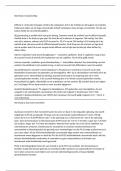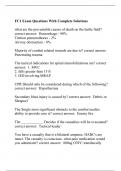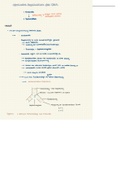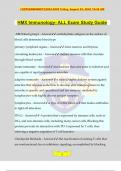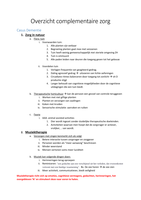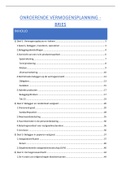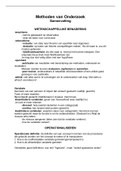Contents
U1: The financial system
U2: Money and bond analytics
U3: Money and bond markets
U4: Equity markets
U5: Risk and return
U6: Derivatives - futures
U7: Derivatives - options
U8: Exercises
U9: Financial intermediation
U10: Commercial and investment banking
U11: The financial crisis of 2008
U12: Regulation and supervision
,U1: The financial system
1. The actors
Haves = lenders: possess capital + can lend it out, excess of money
<-> Havenots = borrowers: needs > money, shortage -> have to raise capital
Þ Idea: put excess in good use -> give to havenots (in)direct
Þ Not review individually, but macro-economic perspective
- Corporates: havenot: work with shareholder’s money
- The government: havenot
- Households: crucial haves: have all the money
- The financial industry: netto zero wealth: everything that comes in, goes out
- Rest of the world: depends
Households
Net wealth = assets – liabilities
o Assets = possession that has value in an exchange transaction
- Tangible assets= real assets: value from physical character/utility
- Intangible assets: value from legal claim to future benefit
- Financial assets: intangible assets with claim to future cash
USA: financial > real, India: financial < real, Bel: financial < real but ong same
Asset classes: traditional (common stock, bonds, cash), all kinds of cash instruments
<-> Alternative
• Real estate: financialized, just buy certificate portfolio -> cash flow = rents these buildings
deliver
• Commodities: volatile = dangerous
• Private equity: into start-ups
• Hedge funds: for wealthy/institutional investors
• Venture capital
• Currencies
The Actors
Liabilities = debt
Theo Household Balance Sheet
à Household balance sheet: overview assets/liabilities single household
Real assets
<-> Financial: stocks = receipt for participation in
company
o Bonds: kind of loan
o Mutual funds: portfolio of stocks/bonds
o Deposits: money on the bank
<-> Liabilities: mortgage loan = collateral
o Consumer loans: spread payment for car/tv/
Prof. Dr. M. De Ceuster Introduction to Financial Markets
Growth derives in net wealth
• Value changes in asset/liabilities fe rising stocks
=> growth from good investments
=> wealth = relative = dynamic
, • Net-income from labour/capital/transfers (pension, social security, …)
• Inheritances, gifts
Wealth creation
“Assets put money in your pocket, whether you work or not, and liabilities take money from your
pocket.” Robert Kiyosaki
- Poor family: no liabilities -> spend everything earned on basic necessities
- Middle class: poor families with home
Buy house with leftover money + loan -> long mortgage
- Rich family: real assets which generate income on their own
Stress on collecting items!
=> Wealth not uniformly distributed: rich North America <-> very poor Americans
=> Global wealth pyramids: focus on top, on billionaires -> more possibilities/challenges
=> Table wealth inequality developed countries <-> emerging markets
! SO: households = ultimate owners of all assets in economy = bearers of risk within financial system
Behind every corporate are individuals (inequality between these)
2. Balance sheets of other actors
- Everyone interconnected
Problem
How crisis
do the Balance 2008:
Sheets of people
Other Actors Look Like?didn’t get bigger picture
- Importance government debt: people invest in government: almost risk free -> get interest
Corporates
Corporates
Equity: claim from shareholders, profits increase
shareholder’s wealth
Debt: people want invested money back, have no
say in company
= everything company loans + interest
Trade credit: delayed payment
Importance of ratio: people like to work with
borrowed money -> hope that cost of loan < profit
Fixed assets: LT commitment
Financial: shares in other company -> °groups
=> Leverage: controlling much more with little
money
-> Gearing: companies funded
Prof. Dr. M. De Ceuster Introduction towith
Financial Markets
o Shareholder funds: original equity, right issues, retained profit
, o Debt: use of leverage to raise ROE above ROA
ROE = return on investment, profit/equity -> interesting for shareholders: how much earned with
invested money?
ROA = return on assets, profit/assets -> return on all money used
-> Leverage: measured as
o Debt/equity ratio: gearing ratio = ratio between LTdebt/equity
Net gearing ratio: ratio financial debt/equity
<-> Net financial debt: LTdebt + STdebt – cash – ST financial assets
Bv. 2: €2 debt for every €1 of equity
=> important to define ratios before using!
o Assets/equity ratio: leverage multiplier (LM)
How do the Balance Sheets of Other Actors Look Like?
ROE = ROA X LM
Banks: low ROA -> need lots of leverage to boost ROE
Financial Sector - Bank
Financial sector: bank
Leverage companies: 30 equity, 70 debt
<-> Banks: much more leverage (high debt): take
money from someone -> lend out
• Ur deposits: assets for u, liability for bank (have
to give it back)
Trading book: assets banks have for trading, need
inventory of shares, hold portfolios
How do the Balance Sheets of Other Actors Look Like? => no intention to keep T, just for customer service
Banking book: real banking service = granting loans
Financial Sector - Mutual Fund => interstraight business: transform deposit in
something with higher return fe in government
Financial sector: mutual fund
Prof.
How doDr.the
M. Balance
De Ceuster Introduction
Sheets of Other Actors to Financial Markets
Look Like?
Portfolio manager
who gathers funds: gives u
certificate -> they invest
Financial Sector - Insurance => let someone else buy things for u: pass-through
Company
Financial sector: insurance company
Do 2 things:
- Casualty insurance: cover insured activities, reimburse
- Invest for you: u get back when u die/end contract
Technical provision: estimate contractual obligations ->
Prof. Dr. M. De Ceuster Introduction to Financial Markets invest that to25 /repay
40 contracts, to cover losses
Government
• Liabilities: government debt
• Assets: few, some buildings, stakes in banks, …
Huge debt + hardly assets => negative equity = only entity who can survive this
BUT no problem: families own everything, are wealthy enough for government to raise taxes to pay
Prof. Dr. off
M. Dedebt
Ceuster Introduction to Financial Markets


